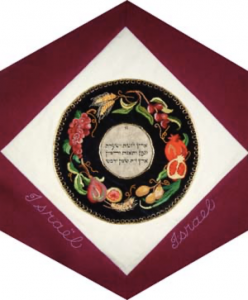Israel

The Block
Chloé Fox stitched the Israel block. Seven richly embroidered plants surround a parchment on which a Hebrew passage from the Torah is written in calligraphy. The words speak of God’s promise that Israel would be “a land of wheat, and barley, and (grape) vines, and fig trees, and pomegranates; a land of olive oil, and (date) honey.” Seven is a significant number that recurs in Jewish beliefs and these ‘fruits of the land’ (the Seven Species), which were among the staple foods consumed during ancient times, are a sign of the abundance of riches found in Israel.
Today the seven species continue to dominate large areas of the countryside, maintaining a link between the ancient land of Israel and the modern state. They are a frequent theme in ornamental and ritual art. They are also used to decorate the succot (booths) that are an important part of the annual Succot or Harvest Festival. A double row of gold-work encircles the plants, replicating a type of embroidery (brought to Israel by Yemenite Jews) that has come to be associated with Israel. The background of blue velvet is typical of fabric used for kipas (skull-caps), for the bags in which tallits (prayer shawls) are carried, and for the covering of the Torah.
Cultural Profile
A small country, Israel is a long, narrow strip of land stretching up the eastern shore of the Mediterranean Sea. The country is the world’s leading producer of polished and industrial diamonds. It was formed in 1948 as a Jewish state in the region of Palestine. It is one of the youngest nations in the modern world, but with a history dating back almost 6,000 years it is also one of the oldest. Israel, which means ‘who prevails with God,’ has had many names including Canaan, Judea and the Holy Land. The city of Jerusalem, which has been continuously inhabited for the past 5 millennia, is a holy city of the Jewish, Christian and Muslim faiths. The population of Israel is comprised mainly of Jewish and Arab people and the official languages are Hebrew and Arabic. Many Israelis also speak English or any of a number of European languages, such as Russian and French. Amharic is also spoken by many, since large numbers of Ethiopian Jews have arrived in the country in the past 30 years.
Israel’s population, drawn from more than 100 different countries, has produced a society rich in cultural diversity and artistic creativity. Israel’s crafts include olive wood carvings, jewellery, hand-woven tallits (prayer shawls), and rugs woven by the Bedouins of the Negev desert. The country’s greatest artistic achievement is the revival and modernization of the Hebrew language after centuries of disuse.
Folk dances (a mixture of Jewish and non-Jewish dance from around the world) such as the hora, are very popular, as are modern dances, ballet, opera, and theatre. The country is world-renowned as an active and progressive centre for music, highlighted by the Israel Philharmonic Orchestra and accomplished musicians such as Itzhak Perlman. Israelis love to sing, and their folk songs preserve the Israel’s stories, passing them on from generation to generation. Israeli painters and sculptors exhibit and sell their works world-wide, and the country is home to many high-quality museums, including the Israel Museum, which houses the Dead Sea Scrolls. Israel’s cinema has also earned a worldwide reputation for its quality. The Jerusalem and Haifa cinema festivals are major events.
The Jews are both a people and a religious group who trace their roots back to the ancient Hebrews. Although Jewish people have been coming to Canada from the newly formed nation of Israel since 1948, Jewish immigrants from around the globe have made significant contributions to the Canadian fabric since the eighteenth century. In 1768 they established Canada’s first synagogue (Shearith Israel) in Montreal and later participated in the settlement of Upper Canada. Jewish men and women have played a major role in all the arts in Canada. Writers such as Leonard Cohen, Mordecai Richler, and Nobel Prize laureate Saul Bellow have made lasting contributions to Canadian literature while Jewish composers, including Louis Applebaum, Harry Freedman and performers from classical to contemporary music have been at the forefront of Canadian music. In the entertainment world, many have attained stardom. Jews have also played an enormous role in the economic sector with families such as the Bronfmans, Reichmanns and Steinbergs, in science, education, law, medicine and politics. Canada is home to the fourth largest Jewish population in the world, and there are large Jewish communities throughout the country.
Sponsor: Judith Jolly, in memoriam Larry Schwartz, and Dorothy Taylor-Kreher
